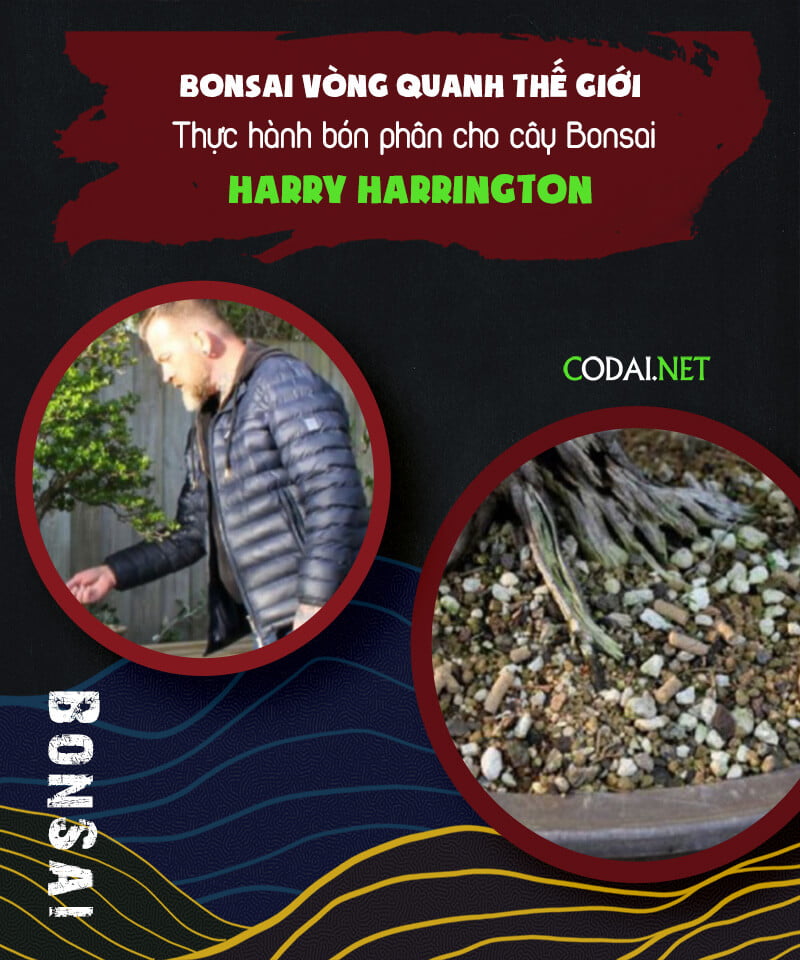Bonsai, Bonsai Focus Magazine, Chia sẻ kinh nghiệm
Hướng dẫn thực hành Bón phân cho cây Bonsai – Harry Harrington, Bonsai Focus Studio – Số 07/08 năm 2019
Nguồn: Tạp chí Bonsai Focus English Edition T7/T8 2019
Dịch và biên tập: Dũng Cá Xinh (10/08/2021)
English
A solid regime…
Harry’s practical guide to fertilising
- Bài viết và ảnh của: Harry Harrington, Bonsai Focus Studio
Bonsai need water, air and sunlight in order to photosynthesis and grow.
The combination of these three elements is enough for a tree to manufacture the sugars and starches it requires from its leaves. Harry Harrington explains how to fertilise your bonsai by taking a no-nonsense attitude, during the growing season
As the keepers of bonsai, we can to an extent govern how a tree grows, by using fertilisers. Fertilisers are to our bonsai what vitamins and nutrients are to our children. Better the quality of nutrients they absorb, the better they grow!
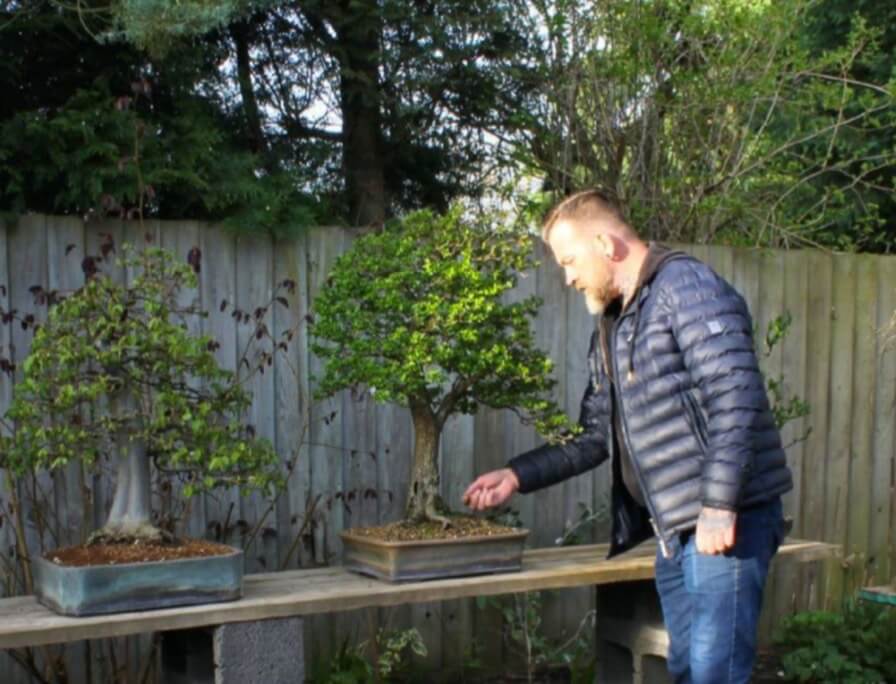
We can influence strong vegetative growth using high nitrogen feed, or tight, fine growth using low nitrogen. Using high phosphorous levels in a fertiliser, we can encourage flowering at the expense of vegetative growth.
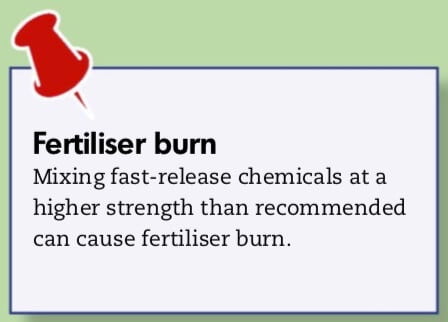
It is, however, very easy to get bogged down by complex feeding regimes and variations of fertiliser components. My personal opinion is that, when regularly feeding an entire bonsai collection on a season-long basis, there is little difference between many fertiliser products and it is far easier and only necessary to follow a straightforward fertilising regime. This is particularly so when one then considers that any slight advantage in one product over another can easily be lost to the weather, heavy rainfall, or poor watering practises.
The intention here is not to provide an exhaustive text on the chemical and biological pros and cons of any given preparation, nor is it intended as a primer for fertiliser; these are widely availablein books and online. Rather, I hope, it is a practical guide to getting the best out of your trees by providing them with a solid fertilising regime.
Slow-Release Organic Fertilisers
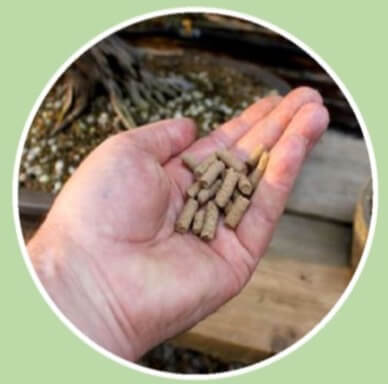
These are available as pellets that are laid on the surface of the soil. As the tree is watered, the pellets break up and are absorbed into the soil itself. This means that they are not left on the soil’s surface attracting the local wildlife and looking an unsightly mess!
Although slow-release organic fertilisers are relatively weak, with a NPK of around 3-3-3, they are composed of natural ingredients that are broken down slowly by bacterial and fungal activity in the soil, slowly releasing their nutrients on a continual basis. This means nutrients are always available to your trees. Compare this to liquid chemical feeds that maybe as strong as 20-20-20 at their peak, but are rapidly dispersed from our inorganic soils during rain and watering.
Organic fertilisers are also just that, they add an organic, microbial element to our largely inorganic modern soils and this helps create a healthier ecosystem within a bonsai pot.
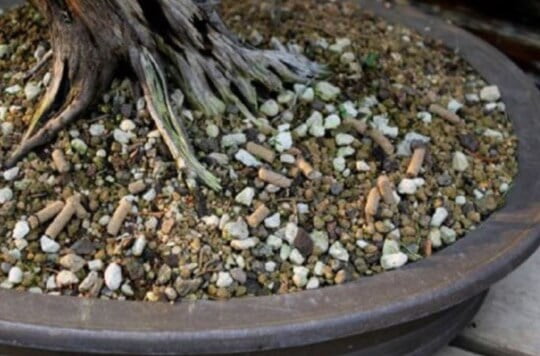
Unless temperatures are reliably above 12C, plants don’t start absorbing nitrogen. This fact leads to a number of interesting conclusions. Firstly, fertilisers applied to the soil at the time of leaf burst, typically when daytime temperatures reach double figures, yet they are still not utilised until the tree is ready.
Secondly, organic fertiliser still present in the soil as temperatures drop back down to single figures in the autumn afterthe growing season is left unused and remains locked up in the soil until the following spring. There is no requirement to feed a low nitrogen 0-10-10 fertiliser at the end of the growing season as the tree stops absorbing nitrogen anyway.
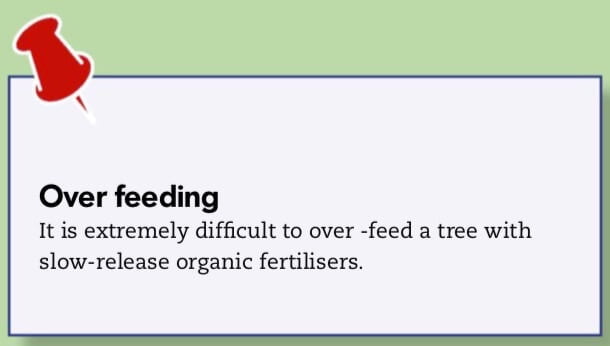
Fast-release liquid chemical fertilisers
These fertilisers are diluted with water and applied to the soil as one would when watering our trees. I typically use a regular brand high nitrogen fertiliser that’s intended for trees and plants and available in supermarkets and garden centres.
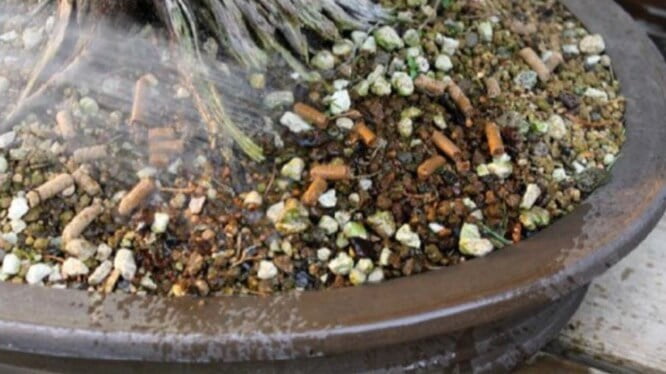
Liquid fertilisers are applied at regular intervals according to the manufacturers’ recommendations (typically 10-12 days), and should be considered a short-lived ‘boost’ to your trees that require strong and vigorous growth and where coarse growth is not an issue. Within hours of application, the levels of the fertiliser in a modern inorganic soil will have started to deplete. This is particularly true after watering and during rainy weather. Itis possible that within days the level of chemical fertiliser can become very low and nutrients are no longer available to the tree until the next application.

Feeding regimes for bonsai
How you feed your bonsai and bonsai collection as a whole is dependent on the types of growth you require, and how much time you are willing to invest every couple of weeks throughout the growing season, actively feeding your trees.
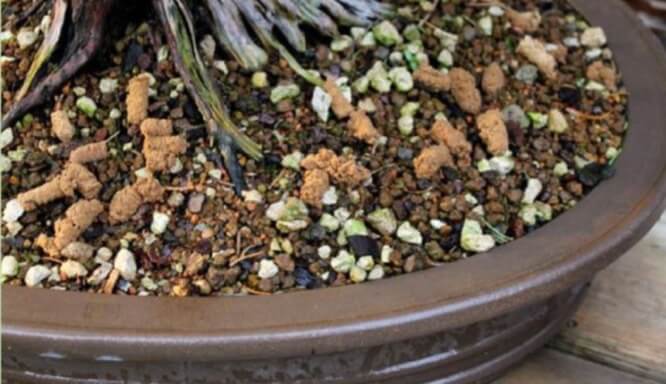
Most straightforward, all-encompassing fertilising regime is to apply an organic, slow-release fertiliser to the surface of the soil every 6-8 weeks throughout the growing season. That is, when your trees are actively growing. This will make a healthy mix of nitrogen, phosphorus and potassium, plus trace elements available to your trees from spring until autumn.
For a very basic feeding regime, give an application of fertiliser to all trees in spring and a second at mid-summer to keep them adequately fertilised for an entire growing season. This basic feeding regime should be considered essential to keep any bonsai collection healthy and vigorous.
Deciduous trees in development
If a deciduous tree still requires growth to build either the trunk, or the primary and secondary branches, employ a heavy feeding regime with plenty of nitrogen.
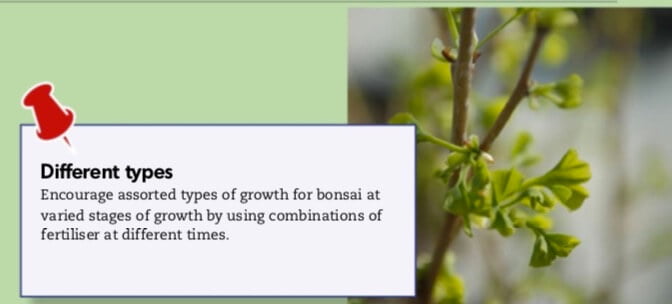
I use a base feed of 3-3-3 organic fertiliser, applied to the soil surface every 6 weeks from leaf break to early autumn.
A high nitrogen 20-20-20, or even 24-8-16 liquid feed, is then applied every 12-14 days (in addition to the slow-release fertiliser). Apply from leaf break until late summer when growth on deciduous trees typically slows. This ‘super feeding’ will encourage very rapid growth, vigour and development in healthy trees.
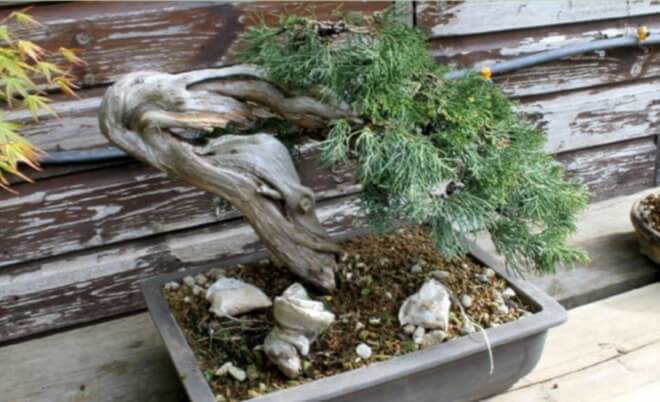
For species that typically exhibit very coarse growth in spring, I will wait until the first flush of growth has hardened off before beginning liquid feeds. This will discourage unusably-coarse elongation in specially vigorous trees that would simply need removing at a later date, particularly if developing secondary branches. Once the spring flush has occurred, further flushes are naturally shorter and repeated fertilising with a high nitrogen liquid fertilisers is started.
Deciduous trees in refinement
Finished deciduous trees require more refined growth with short internodes. However, we ideally still want them to be vigorous and offer repeated flushes of growth each year in response to pruning and defoliation.
For naturally vigorous species I hold back from using any fertiliser until the first flushes of spring growth have finished, then an organic fertiliser is applied every 6 weeks for the remainder of the season. Once mid-summer has been reached and any (partial) defoliation has taken place, I then start to additionally fertilise with high nitrogen fertiliser to encourage as many repeat flushes of growth as it is possible. If you feel that elongation on any particular tree is too long, withdraw the liquid fertiliser.
Flowering species
Some flowering trees flower regardless of the applied fertilising regime. Some trees, like the hawthorn (crataegus monogyna), pyracantha or blackthorn (Prunus spinosa) are more reluctant to flower. Care should be taken to avoid feeding these species with high nitrogen liquid fertilisers from late in the summer onwards as nitrogen will encourage vegetative growth at the expense of flowers.
Coniferous species excluding pines
Feed with organic slow-release fertiliser from early spring, this is indicated when deciduous trees come into leaf and the soil of junipers begin to dry out rapidly for a 2-3 week period. It is very important that coniferous species have an added organic element to their soils due to their reliance on microbial activity.
Additional liquid fertilisers can be applied from late spring onwards to encourage elongation, as necessary. Be aware that high nitrogen will encourage juvenile growth in juniper types susceptible to it.
Pine species
This feeding regime is based on the fact that in the UK and Northern Europe, all pine species can be considered one-flush pines. We have neither the temperatures nor length of growing season for pines to have two true flushes of growth.
Fertilising a pine as the buds elongate into candles in spring will encourage growth of longer candles followed by longer needles. If refined growth and short needles are required, withdraw fertiliser until the needle-size is set, around mid-summer.
If strong and vigorous growth is required at the expense of having longer needles, for instance when developing trunks, you can fertilise with organic and/or liquid fertiliser from early spring onwards.
Typically, pines are worked on from late July, being pruned, needle-plucked and wired. At this point the needle-size of the current year is set and we want to prompt a vigorous response to the late summer pruning and also to fuel production of new buds for the following year. For all pines, an application of organic fertiliser should be applied from late summer, and when requiring maximum development, liquid feeds can be applied until early autumn when ambient temperatures drop and nitrogen is no longer required by the tree.
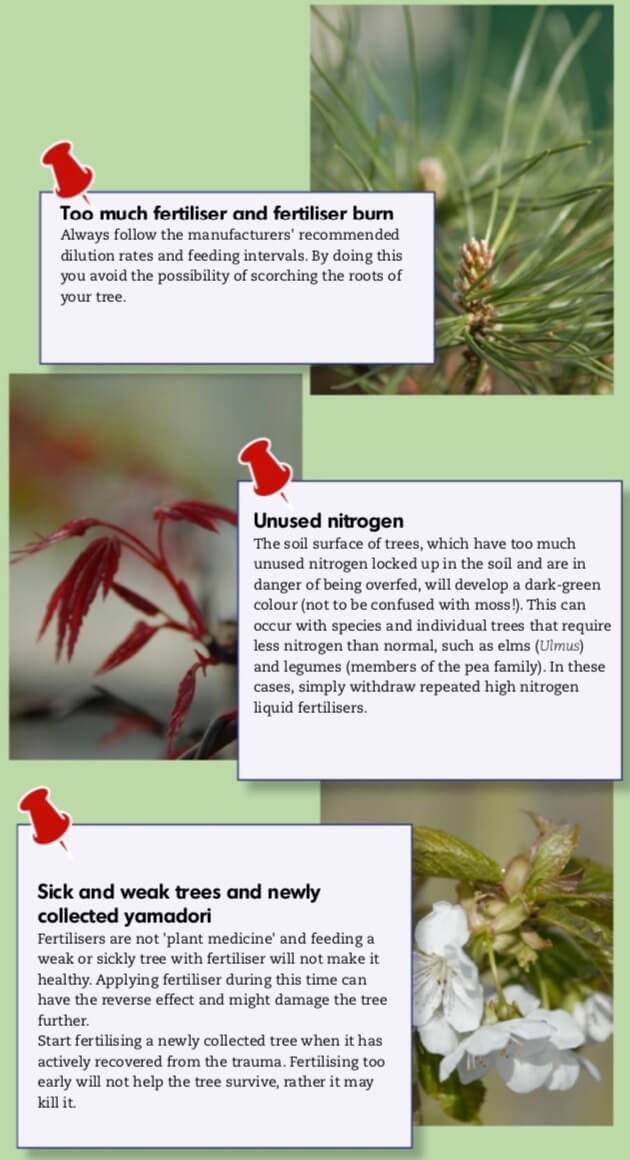
- Too much fertiliser and fertiliser burn: Always follow the manufacturers’ recommended dilution rates and feeding intervals. By doing this you avoid the possibility of scorching the roots of your tree
- Unused nitrogen: The soil surface of trees, which have too much unused nitrogen locked up in the soil and are in danger of being overfed, will develop a dark-green colour (not to be confused with moss!). This can occur with species and individual trees that require less nitrogen than normal, such as elms (Ulmus) and legumes (members of the pea family). In these cases, simply withdraw repeated high nitrogen liquid fertilisers.
- Sick and weak trees and newly collected yamadori: Fertilisers are not ‘plant medicine’ and feeding a weak or sickly tree with fertiliser will not make it healthy. Applying fertiliser during this time can have the reverse effect and might damage the tree further. Start fertilising a newly collected tree when it has actively recovered from the trauma. Fertilising too early will not help the tree survive, rather it may kill it.
Tiếng Việt
Một chế độ nghiêm túc…
Hướng dẫn thực hành bón phân cho Harry chia sẻ
- Bài viết và ảnh của: Harry Harrington, Bonsai Focus Studio
Cây cảnh cần nước, không khí và ánh sáng mặt trời để quang hợp & phát triển. Sự kết hợp của ba yếu tố này là đủ để cây sản xuất đường và tinh bột cần thiết từ lá của nó. Harry Harrington giải thích cách bón phân cho cây Bonsai của bạn bằng cách thực hiện thái độ nghiêm túc trong mùa sinh trưởng
Là những người chơi Bonsai, ở một mức độ nào đó, chúng ta có thể chi phối cách cây phát triển bằng cách sử dụng phân bón. Phân bón đối với cây Bonsai cũng giống như vitamin và chất dinh dưỡng đối trẻ con. Chất lượng dinh dưỡng mà chúng hấp thụ càng tốt thì chúng càng phát triển tốt hơn!

Chúng ta có thể tác động đến sự phát triển sinh dưỡng mạnh mẽ bằng cách sử dụng phân bón có hàm lượng nitơ cao, hoặc sự phát triển chậm, gọn bằng cách sử dụng lượng phân nitơ thấp. Sử dụng hàm lượng phốt pho cao trong một loại phân bón, chúng ta có thể khuyến khích cây ra hoa với và giảm sự phát triển sinh dưỡng.

Tuy nhiên, nó rất dễ bị sa lầy bởi chế độ cho ăn phức tạp và thường xuyên thay đổi của các thành phần phân bón. Ý kiến cá nhân của tôi là, khi thường xuyên bón phân toàn bộ bộ sưu tập Bonsai theo mùa, có rất ít sự khác biệt giữa nhiều sản phẩm phân bón và sẽ dễ dàng hơn rất nhiều nếu chỉ tuân theo một chế độ bón phân đơn giản. Điều này đặc biệt xảy ra khi nhiều chuyên gia cho rằng bất kỳ lợi thế nhỏ nào của sản phẩm này so với sản phẩm khác đều có thể dễ dàng bị mất đi do thời tiết, lượng mưa lớn hoặc do thực hành tưới nước kém.
Mục đích ở đây không phải là cung cấp một văn bản đầy đủ về những ưu và nhược điểm về mặt hóa học và sinh học của bất kỳ chế phẩm nhất định nào, cũng không nhằm mục đích quảng bá phân bón; những vấn đề có có nhiều trong những cuốn sách cũng như trên mạng trực tuyến. Thay vào đó, tôi hy vọng có thể chia sẻ một hướng dẫn thực tế để tận dụng tốt nhất cây của bạn bằng cách cung cấp cho chúng một chế độ bón phân hợp lý.
Phân hữu cơ tan chậm

Chúng có sẵn dưới dạng viên nén được đặt trên bề mặt của đất. Khi cây được tưới nước, các viên nén này sẽ vỡ ra và tự hấp thụ vào đất. Điều này có nghĩa là chúng sẽ không bị bỏ lại trên bề mặt đất, thu hút các loài động vật hoang dã địa phương và trông như một mớ hỗn độn khó coi!
Mặc dù phân hữu cơ tan chậm tương đối yếu, với NPK khoảng 3-3-3, chúng bao gồm các thành phần tự nhiên được phân hủy từ từ bởi hoạt động của vi khuẩn và nấm trong đất, từ từ giải phóng chất dinh dưỡng một cách liên tục. Điều này có nghĩa là chất dinh dưỡng luôn có sẵn cho cây của bạn. So sánh điều này với phân hóa chất lỏng có thể mạnh đến 20-20-20, nhưng có thể dễ dàng nhanh chóng bị phân tán khỏi đất vô cơ của chúng ta khi gặp mưa và tưới nước.
Phân hữu cơ bổ sung một yếu tố hữu cơ, vi sinh vào các hỗn hợp giá thể hiện đại (phần lớn là vô cơ) và điều này giúp tạo ra một hệ sinh thái lành mạnh hơn trong một chậu cây Bonsai.
Trừ khi nhiệt độ cao hơn 12 độ C một cách đáng tin cậy, thực vật sẽ không bắt đầu hấp thụ nitơ. Thực tế này dẫn đến một số kết luận thú vị. Thứ nhất, phân bón được bón vào đất vào thời điểm lá bung ra, thường là khi nhiệt độ ban ngày lên đến con số gấp đôi, nhưng chúng vẫn không được sử dụng cho đến khi cây đã sẵn sàng.
Thứ hai, phân hữu cơ vẫn tồn tại trong đất khi nhiệt độ giảm trở lại mức đơn lẻ vào mùa thu sau khi mùa sinh trưởng sẽ không được sử dụng và bị nhốt trong đất cho đến mùa xuân năm sau. Không bắt buộc phải bón phân ít nitơ 0-10-10 vào cuối mùa sinh trưởng vì dù sao cây cũng ngừng hấp thụ nitơ.


Phân hoá học dạng lọc tan nhanh
Những loại phân bón này được pha loãng với nước và bón vào đất như khi tưới cây. Tôi thường sử dụng loại phân bón phổ thông có hàm lượng nitơ cao dành cho cây thân gỗ và thực vật nhỏ. Chúng có bán ở các siêu thị và trung tâm làm vườn.
Phân lỏng được bón định kỳ theo khuyến cáo của nhà sản xuất (thường là 10-12 ngày), và nên được coi là một ‘sự thúc đẩy’ ngắn hạn cho cây, những cây đòi hỏi sự phát triển mạnh mẽ và hoặc những nơi mà sự phát triển thô không phải là một vấn đề. Trong vòng vài giờ sau khi bón, lượng phân bón trong đất vô cơ hiện đại sẽ bắt đầu cạn kiệt. Điều này đặc biệt đúng sau khi tưới nước và trong thời tiết mưa. Có thể trong vài ngày tới lượng phân bón hóa học có thể trở nên rất thấp và chất dinh dưỡng không còn đủ cho cây cho đến lần bón tiếp theo.
Chế độ bón phân cho Bonsai
Cách bạn bón phân Bonsai và bộ sưu tập Bonsai nói chung phụ thuộc vào sự phát triển mà bạn yêu cầu và lượng thời gian bạn sẵn sàng đầu tư, có thể là vài tuần một lần trong suốt mùa sinh trưởng.

Chế độ bón phân toàn diện, đơn giản nhất là bón một loại phân bón hữu cơ, tan chậm lên bề mặt đất 6-8 tuần một lần trong suốt mùa sinh trưởng. Đó là, khi cây của bạn đang phát triển tích cực. Điều này sẽ tạo ra một hỗn hợp lành mạnh của nitơ, phốt pho và kali, cùng với các nguyên tố vi lượng có sẵn cho cây của bạn từ mùa xuân cho đến mùa thu.
Đối với một chế độ bón phân rất cơ bản, hãy bón phân cho tất cả các cây vào mùa xuân và một lần thứ hai vào giữa mùa hè để giữ cho chúng được bón đầy đủ cho cả một mùa phát triển. Chế độ bón phân cơ bản này nên được coi là điều cần thiết để giữ cho bất kỳ bộ sưu tập Bonsai nào khỏe mạnh và có sức sống.
Cây rụng lá trong giai đoạn phát triển
Nếu cây rụng lá vẫn cần đâm chồi để tạo thân, hoặc cành chính và cành thứ cấp, hãy áp dụng chế độ cho ăn nhiều đạm với nhiều nitơ.

Tôi sử dụng phân cơ bản là phân hữu cơ 3-3-3, bón lên bề mặt đất 6 tuần một lần từ khi ngắt lá đến đầu mùa thu.
Sau đó bón phân lỏng có hàm lượng nitơ cao 20-20-20, hoặc thậm chí 24-8-16. Bón 12-14 ngày một lần (ngoài phân bón tan chậm). Bón từ khi lá rụng cho đến cuối mùa hè khi sự phát triển của cây rụng lá thường chậm lại. Chế độ ‘Siêu bón phâ’ này sẽ khuyến khích việc đâm chồi, sức sống và sự phát triển nhanh hơn ở những cây khỏe mạnh.

Đối với các loài biểu hiện sự phát triển lỗ mãng (phát triển lộn xộn bất quy tắc) vào mùa xuân, tôi sẽ đợi cho đến khi những chồi non cứng lại trước khi bắt đầu bón phân dạng lỏng. Điều này sẽ không khuyến khích việc phát triển lỗ mãng ở những cây có sức sống đặc biệt (những cành nhánh này có thể dễ dàng bị loại bỏ vào một thời gian sau đó), đặc biệt là nếu cây đang phát triển các cành thứ cấp. Một khi việc bón phân lỏng diễn ra vào mùa xuân, các lần bón phân lỏng tiếp theo sẽ ngắn hơn một cách tự nhiên và việc bón phân lặp lại bằng phân lỏng có hàm lượng nitơ cao được bắt đầu.
Cây rụng lá trong quá trình tạo kiểu
Những cây rụng lá đã hoàn thành việc tạo dáng đòi hỏi sự phát triển tinh tế hơn với cành nhánh ngắn. Tuy nhiên, chúng tôi cảm thấy lý tưởng nhất vẫn là muốn chúng trở nên mạnh mẽ và đâm chồi lặp đi lặp lại mỗi năm như một cách phản ứng với việc bị cắt tỉa và rụng lá.
Đối với những loài có sức sống tự nhiên, tôi hạn chế sử dụng bất kỳ loại phân bón nào cho đến khi đợt đâm chồi đầu tiên của mùa xuân kết thúc, sau đó bón phân hữu cơ 6 tuần một lần trong phần còn lại của mùa. Khi đã đến giữa mùa hè và bất kỳ sự rụng lá (một phần) nào bắt đầu xảy ra, tôi sẽ bắt đầu bón phân bổ sung bằng các loại phân bón có hàm lượng nitơ cao để khuyến khích càng nhiều đợt đâm chồi lặp lại càng tốt. Nếu bạn cảm thấy thời gian kéo dài trên bất kỳ cây cụ thể nào quá dài, hãy dừng bón phân lỏng.
Các loài cây ra hoa
Một số cây hoa ra hoa bất kể chế độ bón phân nào được áp dụng. Một số cây, như cây Táo Gai (Hawthorn, Crataegus monogyna), Táo Đen (Pyracantha, Blackthorn, Prunus spinosa) khó ra hoa hơn. Cần chú ý tránh cho những loài này ăn phân lỏng có hàm lượng nitơ cao từ cuối mùa hè trở đi vì nitơ sẽ khuyến khích sự phát triển sinh dưỡng và làm mất khả năng ra hoa.
Các loài cây lá kim (trừ Thông)
Bón bằng phân bón hữu cơ nhả chậm từ đầu mùa xuân, thời điểm khi cây rụng lá bắt đầu ra lá mới và đất của cây bách xù bắt đầu khô nhanh trong khoảng thời gian 2-3 tuần. Điều rất quan trọng là các loài cây lá kim phải bổ sung một yếu tố hữu cơ vào đất của chúng do sự phụ thuộc vào hoạt động của vi sinh vật (microbial).
Phân bón dạng lỏng bổ sung có thể được áp dụng từ cuối mùa xuân trở đi để khuyến khích cây mọc dài, khi cần thiết. Cần biết rằng lượng nitơ cao sẽ khuyến khích sự phát triển của cây non ở các loại cây bách xù nhạy cảm với Nitơ.
Các loại thông
Chế độ bón phân này dựa trên thực tế là ở Anh và Bắc Âu, tất cả các loài thông đều có thể được coi là cây thông một lá. Chúng tôi không có đủ nhiệt độ cũng như độ dài của mùa phát triển để cây thông có hai đợt phát triển thực sự.
Bón cây thông khi các chồi kéo dài thành nến vào mùa xuân sẽ khuyến khích sự phát triển của những cây nến dài hơn, sau đó là những lá kim dài hơn. Nếu cần đến sự phát triển tinh tế và cây kim ngắn, hãy rút phân bón cho đến khi kích thước cây kim được thiết lập, vào khoảng giữa mùa hè.
Nếu cần có sự phát triển mạnh mẽ với cái giá là lá kim dài hơn, ví dụ như khi thân cây đang phát triển, bạn có thể bón phân hữu cơ và / hoặc phân lỏng từ đầu mùa xuân trở đi.
Thông thường, cây thông được xử lý từ cuối tháng Bảy, được cắt tỉa, tuốt kim và đi dây. Tại thời điểm này, kích thước kim của năm hiện tại đã được thiết lập và chúng tôi muốn thúc đẩy một phản ứng tích cực đối với việc cắt tỉa vào cuối mùa hè và cũng để thúc đẩy việc sản xuất chồi mới cho năm sau. Đối với tất cả các cây thông, nên bón phân hữu cơ từ cuối mùa hè, và khi cần sự phát triển tối đa, thức ăn dạng lỏng có thể được bón cho đến đầu mùa thu khi nhiệt độ môi trường giảm và cây không còn cần nitơ.

- Quá nhiều phân bón và cháy do phân bón: Luôn tuân theo tỷ lệ pha loãng khuyến cáo của nhà sản xuất và chú ý khoảng các bón phân. Làm như vậy bạn sẽ tránh được khả năng rễ cây bị cháy xém
- Nitơ chưa sử dụng: Bề mặt đất của cây, có quá nhiều nitơ chưa sử dụng bị nhốt trong đất và có nguy cơ bị bón thừa, sẽ phát triển thành màu xanh đen (đừng nhầm với rêu!). Điều này có thể xảy ra với các loài và cây riêng lẻ cần ít nitơ hơn bình thường, chẳng hạn như cây du (Ulmus) và cây họ đậu (các thành viên của họ đậu). Trong những trường hợp này, chỉ cần dừng bón phân lỏng nhiều nitơ.
- Cây ốm yếu và cây yamadori (cây cổ tàn bệnh lão) mới thu thập: Phân bón không phải là ‘thuốc thực vật’ và việc bón phân cho cây yếu ớt hoặc ốm yếu sẽ không làm cho cây khỏe mạnh. Bón phân trong thời gian này có thể có tác dụng ngược và có thể làm hỏng cây thêm. Bắt đầu bón phân cho cây mới thu thập chỉ sau khi cây đã phục hồi tích cực sau sự xáo động. Bón phân quá sớm sẽ không giúp cây sống được mà có thể làm chết cây.
